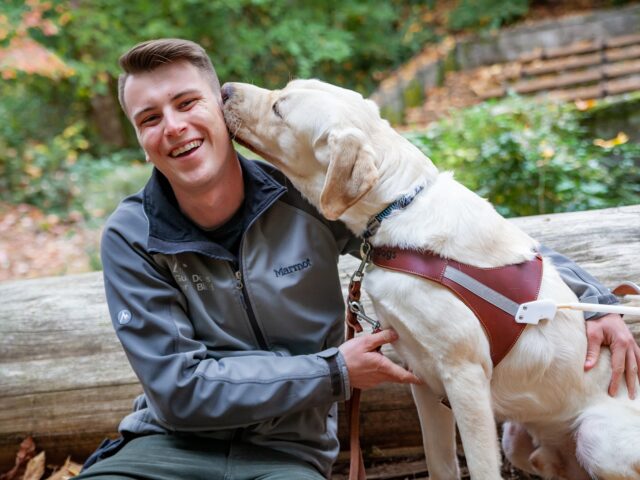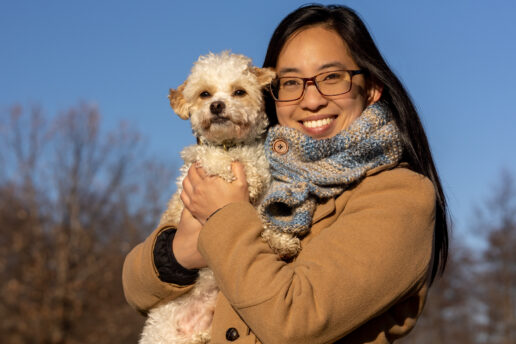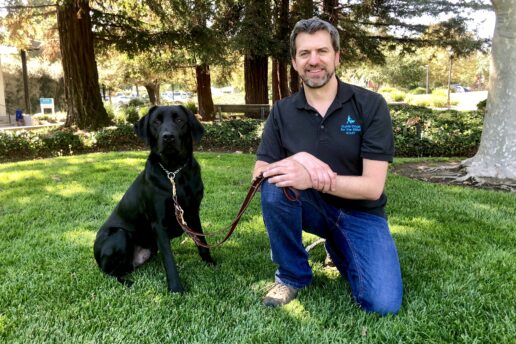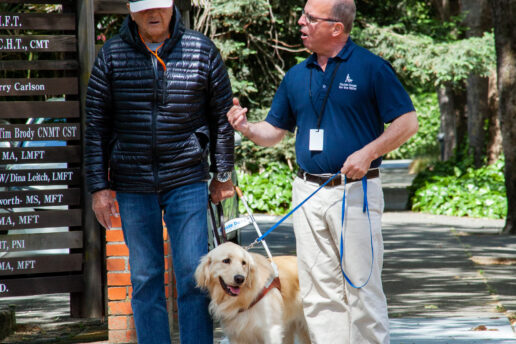
Central Bark Episode 8
The Art of the Match at GDB
Have you ever wondered what goes into finding the perfect dog for our clients? Or how we train dogs to work in such varied and unique environments? This week, Qualified Guide Dog Mobility Instructor, Joey Foat, sits down with Theresa to talk about the science and the art of the matching process and customized training opportunities for GDB clients.
Show notes and transcripts are available at guidedogs.com/podcast.
Theresa: Well, hello, everyone, and welcome to Central Bark. Today, I am joined by guide dog mobility instructor Joey Foat, who works on our Oregon campus, and we're going to discuss probably one of the most interesting parts of what we do here at Guide Dogs for the Blind, and that is the magic and the science behind our matching process. We're also going to talk a little bit about customized training and learn more about our team up at Oregon and Joey in particular. So welcome, Joey. Thanks for being here today.
Joey Foat: Hello. Thank you for having me. I'm so excited to be a part of one of the most exciting things.
Theresa: Exactly. So can you tell us, Joey, a little bit about, I always like to ask people a little bit about their journey to Guide Dogs for the Blind. What brought you to us?
Joey: Absolutely, so I have been at Guide Dogs for the Blind for over five years, almost six now, and I like to say that they need to make the job title lines longer for me on any application, because I'm a qualified guide dog mobility instructor. It's a lot to say.
Theresa: Yes, yes.
Joey: And what it means is I train our dogs and then I get to train our clients too, just to use dogs as mobility aids. Ever since I was little, I've loved dogs and...
Theresa: Ah, okay.
Joey: Yeah. I wanted a dog growing up and my parents actually wouldn't let me get one for a while.
Theresa: Oh, stinkers. Okay.
Joey: And they're going to laugh when they hear this, but, so I ended up volunteering a lot at the local shelter and then I worked with dogs and cats in a boarding grooming facility.
Theresa: Oh, very cool.
Joey: So I got my background with dogs pretty much from the start. I went away to college and I got a degree in communications, and then in my final shift of one of my actually part-time jobs, someone said to me, "What's next?" And I had absolutely no clue.
Theresa: Yes. I think we've all been there one time or another. Yeah.
Joey: Yeah. And so I said, "I don't know, I want to work with animals, I want to work with people."
Theresa: Yeah.
Joey: "I'm not really quite sure what", and she said, "Well, have you looked into Guide Dogs for the Blind?"
Theresa: Oh.
Joey: And what a dream that she mentioned that, because it was the next day I was applying and the next week I was in cahoots with our HR department.
Theresa: That's fantastic. Can we... We need to send her a thank-you letter so you need to see if you can find out her address.
Joey: I know, really.
Theresa: Yeah. That's amazing. And I think, recently, it's worth saying that you just finished your three-year apprenticeship and a completely official guide dog mobility instructor, so congratulations.
Joey: Yes. Thank you. It's very exciting. It's been fun to celebrate.
Theresa: Great. Great. So tell us, Joey, tell us a little bit about this matching process. As a guide dog user myself, I know I've been matched with four amazing dogs and I am always being asked about how that... "Do you get to pick the dog? Do you know how does it work?" And I just be curious to hear from the experts how that all, that whole process comes together, because it is fairly amazing.
Joey: Yeah, I like that you guys started by saying it's a little bit of magic and a little bit of science. It was funny when I heard that this was the topic because I thought, "Oh, my gosh, I need to jot down some notes about what is it?" Because there's so many different aspects that go into it, but it really starts from the beginning of the application process.
Theresa: Okay.
Joey: When we have our clients apply and discuss with us over the phone what they're looking for, what they do, and then we even do a home interview and we learn a lot about the client's lifestyle, the routes they do, what they entail, their ideal walking speed is really important.
Theresa: Oh, yeah. That would be important. Yeah. Mm-hmm (affirmative).
Joey: Yeah. And then, even some... We do some practice to just see how people handle dogs with our famous Juno.
Theresa: Let's explain to everybody what Juno is, because I think that's kind of a insider term, so tell us a little bit about Juno.
Joey: Yeah, so Juno is what we refer to as a empty harness. The instructor simulates what it will feel like to work with a dog, follow a dog and even handle in certain ways.
Theresa: Great. Interesting. And I know that we have clients who live across the U.S. and Canada so I think this whole idea that you're doing the home interview makes a lot of sense because there's lots of different environments, correct? That people live in?
Joey: Yes. I think that's really important. That's a big thing that we look at. Some people work in environments that are kind of city environment and some are smaller. Some dogs do better in city environments or smaller environments, so we try to take that into consideration.
Theresa: Gotcha. Gotcha. So you get the kind of the info on the people and then how are you getting the information on the dogs?
Joey: Yeah, so through the training cycle, we are paying attention to those same things, the dogs' speed that they enjoy walking.
Theresa: Okay. Yeah.
Joey: What kind of work environment they thrive in and then also what handling style they respond to best themselves.
Theresa: Oh, explain that to me. What do you mean by "handling style"?
Joey: We want to just make sure that we match how a dog works past distractions or just responds to any handling and the client's capability to do so.
Theresa: That makes sense. What about... Do dogs... I mean, I kind of know the answer to this, but talk a little bit about dog personalities and how they kind of match with people personalities. Is there something about that that kind of comes into play too?
Joey: Yeah, absolutely. I mean, I even think about myself and if I want a guide dog, I'd be looking for a dog that cuddles.
Theresa: Yeah.
Joey: And will kind of lay on the ground with me and I can pet the area the whole time and not everyone wants that in a dog. Some people like a little bit more independent personality, and so that's a big factor that we look for is kind of matching what the person wants in a companion is a huge part of it because guide work is only an aspect of the role that they play in our lives.
Theresa: Yeah. No, that's so true. Thanks for saying that. Because when I'm working with my guide dogs, we're out on the street, some of the time, doing the actual guide work, but we're living together 24/7, right? So you guys are really looking... It's almost like a dating app or something, you know? Like trying to match the people with the dogs that... To kind of get along.
Joey: You can't swipe right, can you?
Theresa: I know. I was going to... Exactly, exactly. Oh, my goodness. So sometimes, I'm sure, most of the time, it works out pretty good. Sometimes, is it just sort of like, you think this dog is going to be great with this person, they get together and it's like "wah-wah".
Joey: Yes, and I'm glad you say it, because that... Absolutely.
Theresa: Yeah.
Joey: I think, as much as we try to place the best match, sometimes, in class, it just isn't. It's not the same compatibility and also some people really blossom when they get working with a guide dog.
Theresa: Oh, okay.
Joey: And so maybe they end up wanting to work faster or have different needs than they thought originally.
Theresa: Gotcha.
Joey: And so, yes, it's not always the perfect match from the start and we really strive to find the best match and it's okay to make a switch if needed because this is going to be your companion.
Theresa: Right. Right. Right. Right. So is that kind of something you notice it because the client tells you, or is there certain traits where you could tell the dog is just not loving it? Or how do you kind of tell when something isn't quite right?
Joey: Well, I think that there's a little bit of both, but, of course, our clients are... It's very important for the client to make a decision, and we can guide them as much as possible, but overall, we want to make sure that they feel happy with their decision.
Theresa: Right. Right. That makes sense, definitely. Goodness, can that be sometimes a little bit of a challenging conversation to have, if you're in class and things aren't working out quite right? And how do you sort of manage that?
Joey: It's a hard decision. I think that there's guilt on the client side.
Theresa: Yes. Yeah, yeah.
Joey: Because you know, you take this dog in with you, you spend this time, even if it's a couple days, you've started bonding.
Theresa: Of course.
Joey: But we want to make sure that each aspect of the team meshes well.
Theresa: These dogs, I mean, they just crawl right into your heart the minute you meet them for the first time, so I can imagine that can be a tough decision, but, in the long run, so much better for everybody if they recognize it's not going to be a long-term best for both of them, so I think that's...
Joey: Absolutely.
Theresa: Yeah, that's excellent. Now tell us a little bit, we want to explore, a little bit, some of the customizations that go on in class, because I think people don't realize we have people who come to Guide Dogs for the Blind with lots of different sort of needs and backgrounds, all different ages from young teens to solid gold seniors and with lots of different maybe needs or things like that that are a little more individualized. Can you tell us a little bit about some of those things that we do to make the teams work well together?
Joey: Absolutely, so everyone's lifestyle is different and so, especially in our second week of class, we try to give a lot of opportunities for customization in general, and so whether people are working on and off escalators, public transit, revolving doors, in a park or a trail setting, there's so many different things that people do.
Theresa: Okay.
Joey: And so we like to try to tailor the client's experience in class to similarities to their home life.
Theresa: Ah, okay. That makes sense.
Joey: We might not hit every point, but we try.
Theresa: Mm-hmm (affirmative). Mm-hmm (affirmative). Yeah.
Joey: So we work on a route with aspects that are similar to what they encounter and this really just gives us the opportunity to work together and problem-solve. That way, when you get home, hopefully, you have some of the tools you need when you experience those things for the first time on your own.
Theresa: Yes. It gives you a good foundation, right? For that. So speaking of class and matching and customizing, can you tell me, looking back at the teams that you've worked with, and I imagine you've worked with many by now, do you have a team that kind of stands out as just sort of that pinnacle of, "Wow. This is like kismet that these two are together."
Joey: Gosh, I have so many.
Theresa: Yeah, I bet.
Joey: I have so many. Even in just four years as an instructor, I'm so proud of everyone.
Theresa: Right.
Joey: I really have just loved some of the unique opportunities to customize like we've talked about.
Theresa: Oh, cool.
Joey: I think that I've enjoyed... Something that we think about a lot in guide dog training is when someone has not as a traditional environment, like a campus, like a college campus or...
Theresa: Tricky. Yeah.
Joey: Or... Yeah, or even a campus like we have at Guide Dogs, there's not as many curbs or things for the dog to stop at and get that kibble that they love.
Theresa: Yes. And they do.
Joey: [crosstalk 00:12:23] working for. Yeah, working together in those settings has been really rewarding because you find different ways to motivate your dog. I think that's been really fun to dive into with clients. I've done it in their college campuses and that's been a fun one that I like to think about, and then also kind of in class, finding, "Well, here in Portland we have something that looks like a college campus that we could do." Just saying, "Well, let's find this bench, let's make it fun for both of you."
Theresa: Yeah.
Joey: That's been... Those are the times that I get really proud.
Theresa: Yeah. Yeah, I bet, when you just sort of see it all click together.
Joey: Yes.
Theresa: Pretty amazing. Yeah. Joey, I know you do an amazing job as an instructor at Guide Dogs for the Blind, but you're also involved in some of our other important initiatives. Tell me a little bit about some of the other programs that you're working on. I know you're working on our diversity, equity and inclusion initiative and just some other stuff that you do for Guide Dogs.
Joey: Yeah. So I like to joke that I'm one of the founding members of the diversity and equity and inclusion committee.
Theresa: Oh, well then I should have introduced you [crosstalk 00:13:38].
Joey: I know. We should put it on my email signature.
Theresa: Yes. Yes.
Joey: I came in to Guide Dogs for the Blind right at the start of our DE&I initiative and I was just lucky to be offered to help in it, and it's been amazing, it's just, it's all people wanting to make everyone feel included at Guide Dogs for the Blind and just making sure that we can be as inclusive, as equitable and increase our diversity, and it's been really fun, it's even gone beyond that role and kind of given me just... I get to see what kind of goes on in more leadership roles at Guide Dogs and this work group, and it's just so fun to actually see some big changes happening.
Theresa: That's exciting stuff, and especially for an organization whose vision is all about inclusion, I'm just so glad that we're working on this initiative and so glad to have you as part of that, Joey, it's excellent.
Joey: Thank you.
Theresa: Congratulations. Yeah. Awesome. So what else do you like to do, Joey, out there in Oregon? You were shoveling snow earlier this week.
Joey: Yeah, exactly. I think one of my biggest hobbies is cooking.
Theresa: Oh. Oh, I did not know this. Okay. Good.
Joey: That's kind of how I decompress at night as I go home and I really enjoy just spending time in the kitchen. I grew up with my dad was the big cook in the house...
Theresa: Okay.
Joey: ... and he's showed me a lot of the ropes around the kitchen I've just loved. I just love getting creative. I hardly ever follow a recipe.
Theresa: Oh, good for you.
Joey: And I occasionally pair it with a nice wine.
Theresa: Oh. All right. Well, I'll remember, next time I visit the Oregon campus, to make a reservation.
Joey: Yeah. Absolutely.
Theresa: Chateau Foat or whatever. Yeah. That's awesome. Very cool. And we're all wanting to know, did you ever get a dog?
Joey: That's a great question. So when I was... Oh gosh, in... Gosh, I think it was middle school, I ended up, it was funny, I wrote a persuasive paper to my parents.
Theresa: Oh, you did?
Joey: And I offered to buy a fence, which I had no clue how much a fence costs.
Theresa: Right.
Joey: And they said, "We'll think about it." And I was on the phone with the breeder the next day and we had a dog and we got this just wonderful black Lab, her name was Noni and she was a dream.
Theresa: Oh, my goodness.
Joey: And now I have a dog of my own and she's a brindle German Shepherd/pit bull mix.
Theresa: Oh, what's her name?
Joey: Edie.
Theresa: Edie. Oh, so sweet. Well, I'm glad to hear that you won over the parents. I mean, the persuasive argument essay, for you kids, that might get you what you need if you're listening. That's excellent.
Joey: Yeah.
Theresa: And then to be a communications major in college, I think it all just sort of came full-circle for you.
Joey: Oh, absolutely.
Theresa: That's great. Well, thank you so much for being here, Joey, really appreciate it, and thanks for all the great work that you do serving our clients and really making those special, magical matches. Super appreciate all that you do for us at Guide Dogs for the Blind.
Joey: Yeah, thank you. I'm so happy to be a part of it.
Theresa: For more information about Guide Dogs for the Blind, please visit guidedogs.com.
Related Episodes



